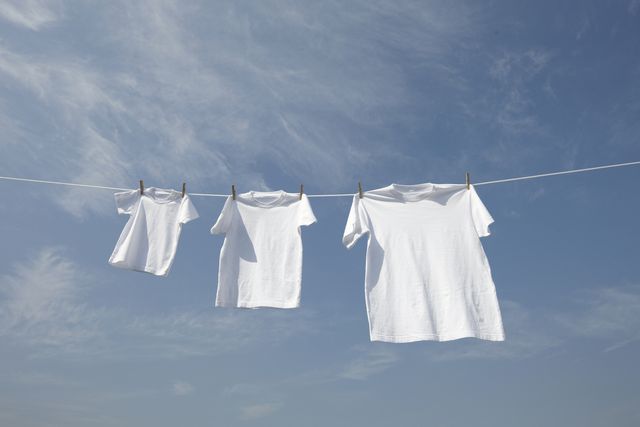A plain white T-shirt is a closet staple. Whether you're using it like it was originally intended — as an undergarment — or rocking it out for everyone to see, a white tee can transition into an off-white tee quickly. Since maintaining your T-shirt's original factory-fresh luster can be confounding, we'll break it down from the beginning.
How to Avoid Stains
Avoid Aluminum in Your Deodorant
Prevention a mess is better than having to clean it up, so let's start with before you even have a less-than-white tee. A common issue with dingy white tees is yellow pit stains. Yellow pit stains aren't caused by your sweat. Rather, they're caused by the aluminum found in many deodorants. Aluminum is great for preventing sweaty pits, but not for keeping your tee clean and pristine. A reaction occurs when the aluminum mixes with the salts of your sweat, which causes the yellow stain.
Wash Your Neck
Dirty collars can be prevented even before you get dressed. Dirt, sweat and even hair products can transfer from your neck to the collars of your shirts. To avoid this, make sure to thoroughly scrub your neck in the shower and rinse it completely of hair products.
How to Wash White Clothes
Don't Wait
When a rogue spot of ketchup bursts from your burger and lands on your tee, it's best to take care of it ASAP. The longer you let a stain sit, the harder it is to get out. Using a clean towel, remove the debris, being careful not to spread the mess further.
Pre-treat
Before you toss your tee in the laundry, it helps to pre-treat and presoak your tees. This allows any stains to break down more before the wash, making it easier to clean once it's actually in there.
For sweat stains, mix equal parts hydrogen peroxide (the 3% kind you find at most drug stores), baking soda and water together. Using a soft-bristled toothbrush, apply the mixture to the stain and gently scrub. Let it sit for about a half hour before laundering.
For soiled collars and cuffs, you can apply detergent directly or use a pretreatment solution. Work the pretreatment into the soiled areas using a soft-bristled toothbrush and let it sit for at least 10 minutes before laundering.
Separate White Clothes
This should be a no-brainer, but we'd be remiss to skip over it. Dyes from colored clothing leech out in the wash cycle and can lightly dye your white clothes. All that pre-treating will have gone to waste, only to see you fumble at the five yard line, pulling out a pink t-shirt from the wash.
Don't Overload the Washer
Now that you've gotten to the washing machine, make sure to give your clothes enough space. Part of the job of the washing machine is to cause agitation in order to release dirt from the fibers of your clothes. That requires room. If you stuff the washer with too many soiled tees, you'll come out with a bunch of tees that are just wet and dirty.
Be Careful with Bleach
Bleach makes sense intuitively. However, it's only effective on certain materials and stains. For instance, bleach isn't effective in getting pit stains out and can actually make them even more noticeable since it whitens every other part of the garment.
Bleach can also damage synthetic materials, especially when overused. If you're going to use it, use it sparingly. Many experts will also recommend avoiding it altogether and instead using a non-chlorine bleach alternative like OxiClean.
Use Detergent with Optical Brighteners
Some detergents are made specifically for white clothes. Rather than using bleach, these detergents use what's called optical brighteners, chemicals that work to visually brighten the look of fabrics. Normally, clean white fabrics are tinted slightly yellow. While we don't necessarily perceive this as dirty, we do perceive it as a less-striking, duller white.
Optical brighteners take in light in the ultraviolet and violet wavelengths and actually re-emit those wavelengths via fluorescence into blue light. This lessens the effect of yellow tints, causing the fabric appear whiter and brighter.
Add Borax or Baking Soda to Your Laundry
For an extra clean kick, you can add some common household ingredients to your laundry. Hard water can hamper bleach and detergent's overall effectiveness, so simply adding more bleach or detergent may not help get your whites to the angelic glow you're after. Baking soda and borax can help increase the overall effectiveness of detergents and bleach.
Use the Hottest Recommended Water Temperature
While cold water is gentler on your clothes and prevents them from shrinking, it's not as helpful for getting rid of stains. Hotter temps are better at loosening debris and breaking up oils. But, some materials can't take hotter temperatures and will get damaged. Basically, follow the label's recommended wash instructions.
Dry Your Clothes Outside
Hanging your sopping clean clothes on a clothes line is an old school way to dry your laundry. But it can also keep your whites looking bright. Ultraviolet waves emitted from the sun can cause bleach the dyes from garments, fading them over time. That's not great news if you want to keep a black tee dark, but it's great for your white tees.























